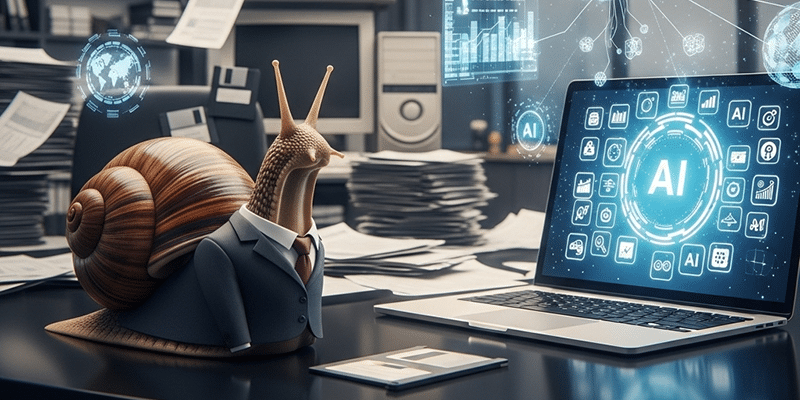

Over the past few weeks, we’ve explored how AI is transforming Digital Asset Management (DAM)—from foundational use cases to the potential of Retrieval Augmented Generation (RAG) and even the rise of autonomous agents. Now, in this final piece of the series, I want to zoom out and offer a broader perspective on where AI is headed—particularly in marketing—and what we can expect in the years ahead.
My goal is to not only spotlight the massive potential of AI across the enterprise, but also shed light on why many organizations are still struggling to unlock its full value.
Prediction 1: AI Adoption Will Remain Slower Than Expected

This might surprise you. If you’re like most people I talk to, you’re already using AI tools like ChatGPT regularly. And in many ways, marketing has been at the forefront of AI adoption, especially for content generation.
So why do I say that enterprise AI adoption remains slow—and will continue to be?
According to HFS Research, only 8% of enterprises have achieved organization-wide adoption of AI. And McKinsey’s latest survey tells a similar story: fewer than 20% of companies report any measurable revenue increase from AI. On the cost side, just 23% have seen savings—only 6% of those exceeding 10%. In fact, 39% report AI has actually increased their costs, underscoring that most organizations are still in the investment and experimentation phase.
AI holds immense promise, but adoption is uneven. The gap between the AI “haves” and “have-nots” is widening—and it’s only going to grow.
Prediction 2: Concerns About Data, Bias, and Accuracy Aren’t Going Anywhere

Why are companies moving slowly? In our experience, the biggest barriers include:
- High cost and long time-to-value for AI applications.
- Security, compliance, and transparency concerns.
- Inconsistent quality or accuracy of AI outputs.
- Shortage of AI-specific skills and resources.
While the last two are already improving—thanks to rapid innovation and growing talent pools—two concerns will linger:
- Data privacy and confidentiality: How is my data being used? Could I be exposing sensitive customer or corporate information?
- Trust in the output: Could AI introduce bias, hallucinations, or flawed recommendations into my business?
These are legitimate fears—but they’re often amplified by misinformation. Large Language Models (LLMs) aren’t inherently dangerous; they’re just sophisticated systems. Like any system, they’re only as good as the data and governance that shape them.
AI isn’t going away. It’s becoming more pervasive by the day. The real question is: how can your organization embrace the technology while managing its risks—before you fall behind?
Prediction 3: Marketing Will Evolve from Generation to Insights and Action

Marketing has always been data-driven—and that’s why it will continue to lead in AI adoption.
AI-powered content generation is just the beginning. What’s coming next is a new generation of agentic marketing tools—autonomous systems that don’t just generate content, but also take intelligent actions across the marketing funnel.
Here are a few emerging use cases:
Customer journey orchestration
Agents will craft hyper-personalized journeys in real time, triggering content, ads, and interactions across channels—without human input.
Dynamic content generation
Campaigns will be personalized at scale, with agents tailoring copy, visuals, and calls-to-action based on behavior and preferences.
Product launch execution
Agents will coordinate launch plans, manage cross-functional activities, track progress, and provide updates—automating much of what’s currently manual.
Ad campaign optimization
AI will allocate budgets, test creative, optimize targeting, and adjust in real time to hit campaign goals.
SEO and content strategy
Agents will run competitive analysis, identify content gaps, and generate SEO-optimized content while tracking results and refining strategy.
Trend monitoring
Continuous scanning of social, news, and competitor channels will surface insights, threats, and emerging opportunities.
Simulation and Scenario Planning
AI personas will test campaigns, messaging, and product ideas before launch—reducing guesswork and risk.
Virtual Assistants
Far beyond today’s chatbots, agents will understand buyer intent and take meaningful actions to drive conversions and resolve issues.
Autonomous reporting and analysis
AI will compile and analyze data from across systems, generate narratives for different audiences, detect anomalies, and surface insights in real time.
In short: Marketing will shift from doing to directing—letting agents handle the execution while humans focus on strategy.
Prediction 4: AI Will Redefine (Not Replace) Work

There’s a lot of speculation about AI eliminating jobs—but I believe it’s more about transformation than replacement.
McKinsey’s research supports this view:
- Only 31% of organizations believe AI will reduce headcount.
- 38% expect no change.
- 19% predict growth in roles where AI is deployed.
- In high-AI-adoption areas, like Marketing, the outlook is even more positive.
AI will automate routine, repetitive tasks—freeing humans to focus on higher-order work: strategic thinking, insight generation, creative problem-solving. Reporting becomes less about gathering and more about interpreting. Customer service reps handle fewer low-level inquiries and spend more time on complex, high-value conversations.
The future of work isn’t less human. It’s more human—but powered by AI.
Prediction 5: We’re Entering the “Trough of Disillusionment”

If the last section was optimistic, here’s a dose of realism.
We’re nearing the “trough of disillusionment” in Gartner’s hype cycle. Expectations for AI are sky-high—and that sets the stage for inevitable disappointment. Here’s why:
- Not all AI is created equal. Some solutions are overhyped or underdeliver, leaving buyers disillusioned.
- Fragmentation is rampant. Teams adopt tools independently, creating new silos, governance headaches, and integration costs.
- Regulation will complicate things. Regional mandates will add compliance complexity.
- Output quality remains inconsistent. AI isn’t hard to use—but it’s hard to get right. Many projects will stall in pilot phases.
This doesn’t mean AI is failing. It just means we’re going through growing pains.
Prediction 6: The Future of AI in Marketing Is Bright

Despite the challenges, I’m very optimistic. Here’s why:
- AI will normalize across the enterprise, becoming as routine as cloud computing or CRM.
- Organizations will get smarter about governance, architecture, and risk management.
- Specialized models will emerge—tailored to industries and even individual functions.
- Costs will drop while performance improves.
- Open standards and frameworks will reduce complexity and accelerate adoption.
Most importantly, businesses will start to see real value:
Revenue growth. Cost efficiency. More meaningful work for employees. Better customer experiences.
Marketing teams—and enterprises as a whole—will look back on this moment not as the peak, but as the beginning.
Learn more about GenAI solutions for your business at vertesiahq.com/solutions.

